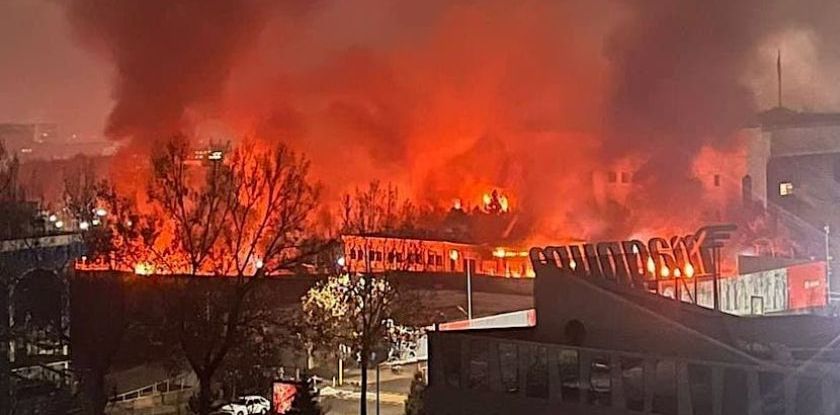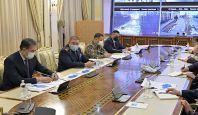The conflict between the protest-minded citizens and the “super-presidential” vertical in Kazakhstan has passed its peak. And even though the authorities are still conducting the “cleaning up” aimed to restore the order and arrest the real criminals, looters and robbers as well as to frighten the Kazakh citizens, the time has come to draw the first conclusions and to forecast the further developments.
In our opinion, the first implication important not so much for the authorities as for the opposition lies in the fact that, in modern Kazakhstan, a peaceful transition of power (be it a “colour” revolution or an inter-elite coup) cannot happen.
It cannot happen due to that simple reason that a civil protest that takes a massive-scale form or an inter-elite conflict that reaches the state of an open “war” will invariably result in the weakening of the power vertical. Which, in its tern, will trigger massive robberies, banditry, vandalism – exactly the way it’s happened this January.
The second implication lies in the fact that the share of the protest-minded Kazakh citizens ready to take action turned out to be much greater than we had thought. Of course, it is still not enough not only to prevent the repressive moves on the part of the authorities but to be able to show resistance to the authoritarian political system across the country.
The third implication that, in our opinion, is going to be proven true every day and every hour of the incoming months lies in the fact that the Kazakh authoritarian political system is a priori oppressive and can exist only when it restricts and represses the willpower of the citizens by forcing them to act in the way the system dictates. Therefore, the more the protest sentiments trespass the limits permitted by Akorda and the Library, the harsher and bigger the repression are going to get.
So, Kassym-Jomart Tokayev’s public order to the siloviks to shoot the “terrorists” without a warning is but a start of the campaign aimed to clean the country off the said “terrorists”.
The fourth implication is that the authoritarian political system and the “super-presidential” vertical formed in Kazakhstan under the leadership of Nursultan Nazarbayev are stronger than we once thought. And they can rather successfully suppress protest outbursts even under the leadership of such politically weak figure as the second President of the Republic of Kazakhstan Kassym-Jomart Tokayev.
It looks like the fear of the revolution and the risks of losing a significant part of the fortunes and the privileges force the Kazakh ruling elite and officials to cling to power by any means possible and mobilise them to go to war with their fellow citizens. So, the death of Nursultan Nazarbayev is not going to lead to an immediate collapse of the system he’s created.
The fifth implication lies in the fact that Kazakhstan and the Kazakh society are developing according to the historical trajectory specific to Eurasia. Of course, the Great October Revolution (or the October coup if you prefer) had arrested this development by making Kazakhstan a part of the USSR thus forcing it to follow a foreign trajectory).
However, the collapse of the Soviet Union had driven Kazakhstan back to the stage of creating the national state in the form that closely resembles a khanate disguised as a republic. And the main part in this was performed not so much by the political talents and the will of the Elbasy as by the quality of the local population stuck somewhere in-between feudalism and capitalism.
We at KZ.expert believe this is exactly what has allowed Nursultan Nazarbayev, his family and allies to appropriate both power and the main state assets.
So, it looks like the country is yet to become a true republic, not only on paper but in actuality which can be achieved only by the means of a bourgeois revolution under the familiar slogans – “Liberty! Equality! Fraternity!”. And there is no guarantee that, before it happens, for a couple a dozen years, the country is not going to exist under the rule of the next “leaders of the nation” each of whom is going to be “wiser, fairer and more successful” than their predecessors.
Our sixth conclusion is the most debatable one.
The thing is that the first serious domestic political crisis in modern Kazakhstan happened in 2001 when a part of the newly-created ruling elite took a stand against Nursultan Nazarbayev and his authoritarianism. At the time, the founders and the member of “The Democratic Choice of Kazakhstan” suffered defeat albeit they did play their historic role of the first protestors acting on the basis of principle and ideology. When this happened, it became clear that the future Elbasy and his henchmen were not ready to even discuss the topic of sharing their power with its source – the people - not to mention to actually do so.
The next serious domestic political crisis broke out in 2011, in exactly ten years after the first one. Back then, thanks to the support on the part of the democratic opposition (mainly of the information and moral nature), the Zhanaozen strikers, driven by the socio-economic motives, had managed to stand up against the authoritarian political system and the “super-presidential” vertical for the whole eight months.
The shooting of the protestors that took place on December 16-18, 2011, and the repressions that followed including the murders of the activists and their loves ones shook down not only Kazakhstan but everyone following these developments.
In January 2022, once again ten years after the previous crisis, Kazakhstan experienced what we would like to call an explosion of the protest sentiments. And, this time, the events shook down the entire world. If the crisis of the fall of 2001 (the founding of “The Democratic Choice of Kazakhstan” was announced on November 18) involved mostly Almaty and did not result in any disturbances, then the Zhanaozen tragedy overtook the entire town and the region where it’s located resulting in a number of deaths and injuries (several times greater than it is officially acknowledged).
As for the January “explosion” of the protest sentiments, it overtook Almaty, several regional centres and other cities while the total number of those involved in both the protests and the robberies constituted hundreds of thousands of people.
So, let us hazard a conjecture that a revolution or an attempt at a revolution in Kazakhstan with the demand to overthrow the political regime and to grant the people access to power is already inevitable. Perhaps it will happen in the year 2031-2032. And under the same slogans. And there is no guarantee that the ruler who is to be overthrown will not have the same surname as the current “leader of the nation”.






